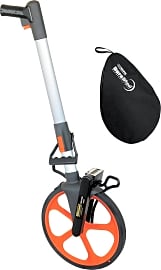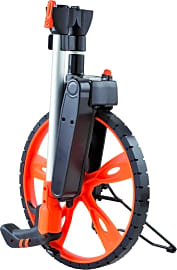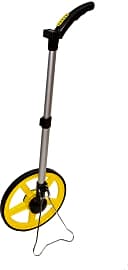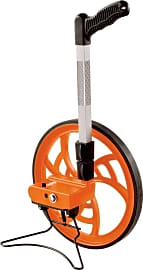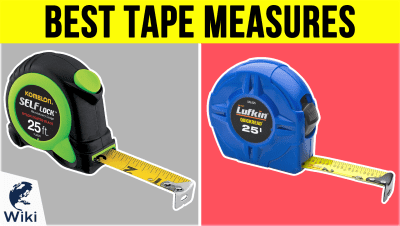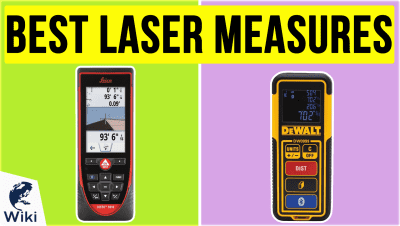The 10 Best Measuring Wheels

This wiki has been updated 46 times since it was first published in June of 2015. Construction personnel, surveyors, real estate professionals, landscape architects and ambitious individuals taking on extensive outdoor projects often need to gauge longer distances than a standard tape measure will allow. One of these measuring wheels will enable you to record accurate distances and ensure that the planning and execution of your job goes as smoothly as possible. When users buy our independently chosen editorial choices, we may earn commissions to help fund the Wiki.
Editor's Notes
April 29, 2020:
Removed the TR Industrial FX Series in favor of the Milwaukee 48-22.
You shouldn't expect one of these wheels to meet all of your measuring needs. While some of them are quite accurate (within a half inch or so), if you're laying out a wall or a subfloor or really anything in a house, a half inch is too great a margin of error. A tape measure allows your layout to be accurate to plus or minus 1/16 of an inch. If you're doing woodworking, even that margin of error is too great. Particularly when making joinery, being 1/16th off is enough to ruin a dovetail. For that you'll need a combination square, which, if used correctly, will get you within 1/32.
Our selections tended to favor the larger wheel because when these sorts of devices are designed with large diameter wheels, it lends itself to greater accuracy. The greater circumference allows a given unit of measurement to be distributed over less of the total circumference of the wheel than in small diameter wheels. To put it simply, models like the Calculated Industries DigiRoller that have more wheel makes it so that a foot will correspond to less of the wheel and so a degree of turn will have more information in it than a comparably small wheel. To be sure, this will also end up depending on the sensitivity of the meter but at the very least, the device's accuracy won't start with the constraint of a small wheel.
Measuring wheels meant for surveying such as the Rolatape Professional serve as a counterexample to this since they will often have large wheels but will typically not be sensitive to units smaller than a foot. Of course, this is a design feature and you won't need to be that accurate when you're surveying thousands of square yards.
When Lesser Measuring Devices Won’t Cut It
The tool is also tailor-made for surveyors, railroad workers, and road maintenance crews who have to measure fairly substantial distances in an efficient manner.
Our ancestors have been measuring distances for centuries. Surveyors, farmers, and city planners have known this useful tool by a variety of names over the years, but today most folks call it a measuring wheel — a title that seems as apt as any, wouldn’t you say?
While it may look somewhat rudimentary, it’s quite effective at its intended purpose: distance quantification. It features markings in fractional increments of revolution that stem from a primary reference position. When the wheel fully rotates, the circumference of the wheel is equal to distance traveled. When it doesn’t rotate fully, you calculate the distance by multiplying the circumference of the wheel by the fraction of a full turn.
Here’s how to use it in practice:
Inspect the surface. Make sure the route is as clean as possible, since obstacles and loose debris will negatively affect the accuracy of the measurement. Position the tool on a precise starting point. Begin walking, pushing or pulling the wheel depending on its design. Stop the device on the exact ending point. Pick the tool up and record your measurement.
Simple enough, right? Professionals in a vast range of industries rely on the measuring wheel as a crucial part of their work when a standard tape measure won’t suffice. It’s also a practical item to keep around the house, as it comes in handy for home gardening and do-it-yourself projects, such as building a fence around the perimeter of your property.
You’ll often see measuring wheels on construction sites — particularly rugged, lightweight models that can easily traverse rough or uneven surfaces. Contractors frequently use them to record the interior dimensions of buildings (and rooms within those buildings), as well.
As you can imagine, farmers and landscapers — those whose livelihoods depend on a firm understanding of the land they’re working on — often require a quality measuring wheel. Other tools, such as a laser measure, don’t offer the range or versatility to get the job done in many situations.
The tool is also tailor-made for surveyors, railroad workers, and road maintenance crews who have to measure fairly substantial distances in an efficient manner. It’s important to note, however, that they only function to record horizontal distance; measuring vertical elevation will require additional tools.
Base Your Choice On The Terrain And Conditions
Your main application will determine most of the characteristics you’ll seek in your measuring wheel, but personal preference will likely dictate which style you select. Your options: mechanical and electronic.
Mechanical models are straightforward and simple to operate (they don’t require batteries), but they usually only offer recordings in one unit of measurement. You’ll need batteries to operate an electronic wheel, but these typically display several units of measurement on an easy-to-read screen.
If you’re looking for a nimble, lightweight unit that won’t rust, go with one that’s primarily made of plastic.
When you begin your search, wheel diameter is a key aspect to consider. Large, utilitarian wheels are ideal for outdoor use, especially if you’ll be crossing rocky or bumpy terrain. They rotate slower than small wheels, which means they'll incur less wear and tear over the long run. You may prefer a more compact wheel for indoor use, as they work better on smooth flooring and allow you to get close to walls. They’re easier to store and transport, as well, which is a helpful attribute for those with occupations that require some travel.
For our purposes, we’ll consider a model with a diameter of 15 inches or more as large — this is what ranchers, landscapers, and farmers will probably want to own. At six to 12 inches in diameter, a medium-sized unit is suitable for construction workers and similar tradesmen. Realtors, indoor contractors, architects, roofers, and flooring professionals may want to go with a wheel smaller than six inches.
Those who tend to work indoors probably won’t require one, but a trigger brake is a critical component for someone who measures uneven surfaces. Rolling over a rock or a curb can send your wheel off its track as it continues to spin, which will lead to an inaccurate recording. With a reliable brake, you can hold the measurement in place to maintain accuracy before you get back on course.
Most models consist of a variety of materials. If you’re looking for a nimble, lightweight unit that won’t rust, go with one that’s primarily made of plastic. Metal units, on the other hand, will be heavier, provide more stability, and stand up to daily use more effectively.
Additional features that will enhance the functionality of your tool include telescoping handles, kickstands, counters, and carrying cases for portability.
The Origins Of The Surveyor’s Wheel
You can trace the earliest known uses of the measuring wheel back to the odometer, but surveyors in the 17th century popularized the modern tool we’re familiar with today.
Many people also use these to measure the energy efficiency of their vehicles, as well.
Typically built with wood and iron, the early devices resembled small wagon wheels. Indeed, wagon builders often constructed measuring wheels, as well. These original manufacturers often mounted a small instrument for reading the distance near the top of the handle. Road builders, mapmakers, and officials working to measure the distance between towns were early users of these tools.
When discussing the measuring wheel, you may also hear it referred to as a surveyor’s wheel, trundle wheel, clickwheel, hodometer, waywiser, or a perambulator — all common terms from decades past that describe the same device.
Throughout history, inventors have created plenty of related gadgets for similar applications. Benjamin Franklin built a new type of odometer in 1775, which he adhered to his carriage to record the mileage of his routes as postmaster. American settlers embarking for the western frontier frequently attached an item called a Roadometer to their wagons to measure the distance they traveled. Near the end of the 1800s, an avid biker came up with the cyclometer, an instrument that measured how many times a bicycle wheel rotated during a trip.
Today, we take for granted that most modern cars come equipped with built-in trip meters that make it extremely easy to record the distance we cover on an individual journey. Many people also use these to measure the energy efficiency of their vehicles, as well.




